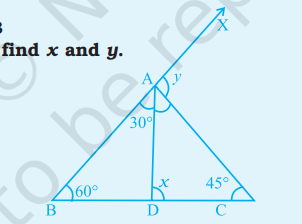In a right-angled triangle, the angles other than the right angle are
obtuse
right
acute
straight
To solve the question "In a right-angled triangle, the angles other than the right angle are", we can follow these steps:
1. Understand the Triangle: In a right-angled triangle, one angle is always 90 degrees. Let's denote the triangle as ABC, where angle B is the right angle (90 degrees).
2. Use the Angle Sum Property: The sum of all angles in any triangle is always 180 degrees. Therefore, we can write the equation:
Angle A+Angle B+Angle C=180∘
Since angle B is 90 degrees, we can substitute:
Angle A+90∘+Angle C=180∘
3. Rearrange the Equation: To find the sum of angles A and C, we can rearrange the equation:
Angle A+Angle C=180∘−90∘
Simplifying this gives:
Angle A+Angle C=90∘
4. Determine the Nature of Angles A and C: Since the sum of angles A and C is 90 degrees, both angles must be less than 90 degrees. This means that both angles A and C are acute angles.
5. Evaluate the Options: Now, let's look at the options provided:
- Option 1: Obtuse (greater than 90 degrees) - Incorrect.
- Option 2: Right (90 degrees) - Incorrect, as both angles cannot be 90 degrees.
- Option 3: Acute (less than 90 degrees) - Correct, as both angles A and C are acute.
- Option 4: Straight (180 degrees) - Incorrect, as no angle can be 180 degrees in this triangle.
6. Conclusion: The angles other than the right angle in a right-angled triangle are acute angles.
Final Answer:
The angles other than the right angle in a right-angled triangle are acute angles.
---
Angle A+Angle B+Angle C=180∘
Since angle B is 90 degrees, we can substitute:
Angle A+90∘+Angle C=180∘
Angle A+Angle C=180∘−90∘
Simplifying this gives:
Angle A+Angle C=90∘
- Option 1: Obtuse (greater than 90 degrees) - Incorrect.
- Option 2: Right (90 degrees) - Incorrect, as both angles cannot be 90 degrees.
- Option 3: Acute (less than 90 degrees) - Correct, as both angles A and C are acute.
- Option 4: Straight (180 degrees) - Incorrect, as no angle can be 180 degrees in this triangle.
The angles other than the right angle in a right-angled triangle are acute angles.
Topper's Solved these Questions
- TRIANGLESBOOK - NCERT EXEMPLARCHAPTER - TRIANGLESEXERCISE - EXERCISE FILL IN THE BLANKS
2 Videos
- TRIANGLESBOOK - NCERT EXEMPLARCHAPTER - TRIANGLESEXERCISE - EXERCISE TRUE OR FALSE
69 Videos
- TRIANGLESBOOK - NCERT EXEMPLARCHAPTER - TRIANGLESEXERCISE - THINK AND DISCUSS
4 Videos
- SIMPLE EQUATIONSBOOK - NCERT EXEMPLARCHAPTER - SIMPLE EQUATIONSEXERCISE - Thick and Discuss
6 Videos
Similar Questions
IfΔPQRandΔXYZare congruent under the correspondence QPR↔XYZ, then
∠R=…….
View SolutionThe difference between the lengths of any two sides of a triangle is smaller than the length of third side.
View Solution
 If AD = DC? Why?
If AD = DC? Why?
View SolutionSolve for x: 8x−12+3x−4=1+2x3
View SolutionProve that in a triangle,other then an an eguilateral triangle,angle opposite the longest side is greater than (2)/(3) of a right angle
View SolutionRight triangle a triangle whose one angle is a right angle is called a right-angled triangle or a right triangle.
View SolutionRIGHT TRIANGLE A triangle whole one angle is a right angle is called a right-angled triangle or right triangle.
View Solutionदो समकोण त्रिभुजों ,में एक त्रिभुज की एक भुजा और एक न्यूनकोण दूसरे त्रिभुज की सांगत भुजा और कोण को बराबर है, सिद्ध कीजिएः की त्रिभुज सर्वर्गसँ है।
View Solutionकिसी त्रिभुज का बहिष्कोण 110∘ है तथा एक अभिमुख अंतः कोण 30∘ हो तो अन्य कोण ज्ञात करें।
View SolutionIn a right angled triangle, the angles other than right angle are-
View SolutionThe side opposite to right angle in a right angled triangle-
View SolutionIn a right angled triangle, one angle is 55∘ , find the other angle.
View SolutionIf one of the right angles of a right triangle is three times the other right angle, find the value of both the right angles in degrees.
View SolutionProve that in a triangle, other than an equilateral triangle, angle opposite the longest side is greater than 23 of a right angle.
View Solutionयदि एक समकोण त्रिभुज की दो भुजाएँ, दूसरे समकोण त्रिभुज की एक भुजा तथा कर्ण के बराबर है तब दो समकोण त्रिभुज सर्वांगसम है।
View Solution
